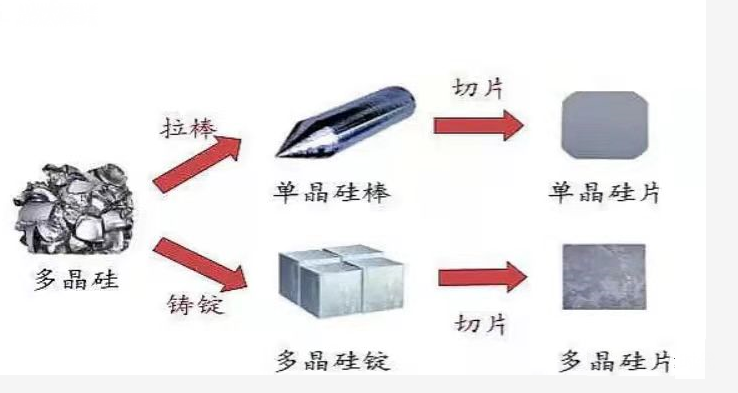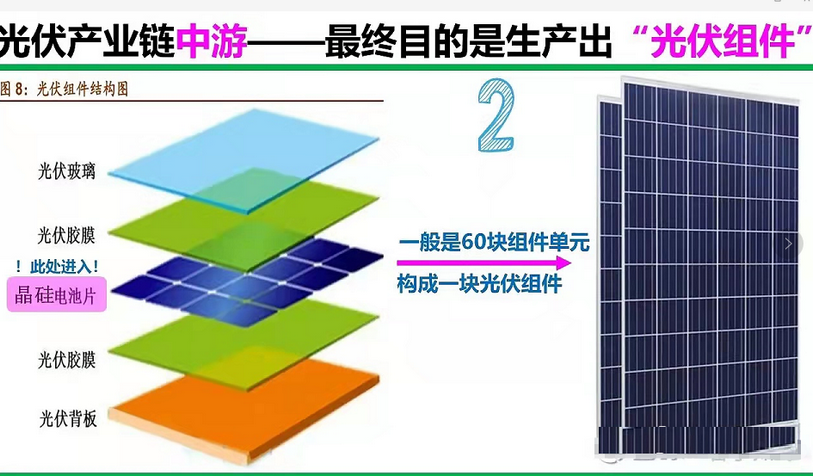| Photovoltaic subdivision track analysis, who is the next dark horse? |
| Release time:2023-02-28 08:34:02| Viewed: |
Photovoltaic production is mainly composed of four parts: silicon material-silicon wafer-cell wafer-module. From silicon wafer-cell, silver paste is needed as auxiliary materials. From cell to module, photovoltaic glass, frame, adhesive film, back plate and other auxiliary materials are involved. The main track downstream of the PV industry chain is the photovoltaic power generation system. The main track involved in the photovoltaic power generation system is the inverter and bracket.
The order of the whole track from large to small is: module - cell chip - silicon chip - silicon material - photovoltaic glass - inverter - bracket - silver paste - frame - adhesive film - backplane.
The order of profits from the main industrial chain of photovoltaic production is: silicon material-silicon wafer-cell wafer-module.
If we look at the income and profit growth of the whole industry in 2020, the order of profit growth of the whole industry is: adhesive film -- silicon material -- battery chip -- inverter -- silicon chip -- bracket -- component.
Then, according to the advantages and disadvantages of the current track, we will focus on the following: silicon material, silicon chip, battery chip, adhesive film, module, inverter and bracket.
1、 The upstream of the photovoltaic industry chain is mainly composed of silicon material and silicon wafer
Silicon material: polysilicon material is made of industrial silicon, which is an electronic material with certain purity after purification through a series of physical and chemical reactions. It is the main raw material for manufacturing polished silicon wafers/solar cells and high-purity silicon products, and the most basic raw material for the information industry and new energy industry. Photovoltaic purity is 6N-9N, and semiconductor purity is 11N. In 2020, the growth of domestic polysilicon production capacity and output will significantly lead the world, accounting for 75%. By the end of 2020, China's top five polysilicon enterprises accounted for 87% of the market share. In terms of silicon materials, the average production cost of polysilicon industry has continued to decline due to the continuous progress of the mainstream technology "improved Siemens method", which has greatly reduced the purchase price of silicon materials for downstream enterprises. To some extent, this has opened up profit space for the downstream, and also stimulated the willingness of enterprises to produce PV modules.
Photovoltaic wafer:
Silicon wafer is the end of the upstream of the industrial chain and the starting point of photovoltaic products. Its shape, size and thickness depend on the production process and downstream product design requirements. The further processing of silicon wafers is crystalline silicon cells, and the cells are solar panels after being arranged, packaged and combined with other auxiliary materials.
Photovoltaic silicon wafers are currently polycrystalline silicon and single crystal. By 2020, the market share of monocrystalline silicon chips will reach 90%. In addition to the competition between monocrystalline and polycrystalline routes, silicon chip manufacturing will also focus on reducing costs. First, it is "getting bigger". At present, there are five mainstream, 156158166182210mm. Second, the loss of silicon material in the production and slicing process will also lead to the increase of production costs. How to reduce silicon consumption is equally important. At present, there are two main ways: reducing the thickness of silicon wafer and reducing the chip loss.
At present, the development route of PV upstream is very clear, and all around reducing costs.
2、 Analysis of individual stocks in the subdivided track
(1) Silicon material
Silicon material is the most basic raw material for the manufacturing of photovoltaic products. It has the characteristics of large capacity investment, complex technology and process, long production cycle, high entry barriers, and high industrial added value. In 2020, the proportion of production capacity of the top five enterprises increased to 86%. C5 has a stable pattern, including the following enterprises: Tongwei Shares, Oriental Hope, Daquan New Energy, Xinte Energy, and GCL (Hong Kong Stock).
(2) Silicon wafers and components
With the landing of affordable photovoltaic, the demand for monocrystalline silicon has surged. For silicon chips, Longji and Zhonghuan are the absolute leaders in the industry, both of which focus on silicon chips and components.
Please look at the picture above, on the far left, in the pink position, this is a crystalline silicon cell, also called a photovoltaic cell, which has the power generation function itself, but it is more delicate. Now you need to add a photovoltaic film (EVA or POE film) on the top and the bottom respectively, and then attach a photovoltaic glass sheet (light blue) on the top, and then add a photovoltaic backplane (dark orange) on the bottom. These things are squeezed together, A structure similar to hamburger is formed, which is called "photovoltaic module unit".
(3) Battery chip
The main focus of the cell is Tongwei, but at present, there is a problem that is the seesaw role of the middle and lower reaches of the photovoltaic industry. The price rise of Tongwei silicon materials led to a higher price rise of silicon wafers produced by Longji, which made the price of Tongwei battery wafers have to rise, but the price rise did not dare to rise sharply, so that the money earned from silicon materials made up for the cell wafers, and was transmitted to the downstream component manufacturers, making the component prices rise, while the investment desire of the most downstream photovoltaic power plant investment enterprises decreased, and this time the rise of silicon materials made many component manufacturers and downstream power plant investment unbearable.
Reaffirm the technological transformation of heterojunction (HJT): the new generation of photovoltaic cell technology after PERC will probably become the mainstream technology of photovoltaic cells in the future.
The main reason is the high photoelectric conversion efficiency of HJT battery, which means that under the same conditions, the battery can convert more electricity, which can shorten the return period of users' investment. Compared with other battery technologies at present, HJT battery has higher basic photoelectric conversion efficiency and more room for improvement.
Compared with PERC battery, the main increment of HJT battery is in silver paste and target material. From the perspective of cost per W battery, the main cost of PERC battery is silicon chip. The main cost of HJT battery is silicon wafer and silver paste; The value of silver paste increased by 11%, and the proportion of target materials increased by 7%.
Impact on the industrial chain:
(1) Equipment: In terms of technology, the current difference lies in the coating process and the market space. According to the current expansion plan, the investment per GW is 350 million. The market space in the past two years is about 4 billion yuan. According to the current production expansion plan of 60W, the market space is 21 billion yuan, with a compound growth rate of 117% in four years. HJT equipment has four major process steps. The corresponding equipment is banyan washing equipment, PECVD equipment, PVD/RPD equipment, and screen printing equipment. The investment in equipment accounts for 10%, 50%, 25% and 15%. At present, the technical difference of the equipment is mainly in the coating process. At present, the mainstream technology line is PVD (physical vapor precipitation).
Maiwei shares: choose PVD equipment, with a market share of 35%, and the whole line supply capacity; Domestic leading enterprises in screen printing have broken the pattern of import monopoly in the field of screen printing equipment; The company is committed to providing HJT whole-line solutions, independently developing PECVD equipment, PVD equipment, screen printing equipment, and HJT equipment is expected to be three times as large as 2020.
Jiejia Weichuang: RPD and PAR equipment are selected, with a market share of 25%. The company's main products are PECVD, diffusion furnace, cleaning and velvet making, automation, screen printing and other production equipment used for multiple main processes in the manufacturing process of single crystal PERC battery.
Jinchen Co., Ltd.: The company is mainly engaged in photovoltaic cell and module automation production equipment, is developing and reserving HJT high-efficiency battery production line and core process equipment, and actively layout the core process equipment PECVD of JHT heterojunction battery.
(2) Cryogenic silver slurry: it accounts for a large proportion of the production cost (25%). It is estimated that the scale will exceed 12 billion yuan in 2025, and the market share will be 1.2 billion yuan in 2020, with a space of ten times in five years.
Suzhou solid technetium: the current market rate is 10%, and it is the core company of low-temperature silver slurry in China. It is estimated that the market share of low-temperature silver slurry of the company will be 30% in the future.
Tec Co., Ltd.: The company's products have achieved full coverage of P-type batteries, N-type heterojunction batteries, etc. Especially in the field of N-type batteries, Tec is a rare supplier in the industry that provides full-scene metallization solutions for the front and back.
(3) Target: target is a new increment of HJT compared with PERC battery, and there is also room for domestic substitution. It is estimated that the market space will be 7 billion yuan in 2025, and the target will also bring the demand for upstream indium.
Longhua Technology: The company is actively deploying ITO targets applied to HJT, and the product testing on the client is progressing smoothly
(4) Silicon wafer: Thinning itself is a trend. The price can be reduced by 10-15% for each 20um reduction. The demand for thin silicon wafers is accelerated by the thinness and cost of HJT batteries.
(5) Component technology: The way for components to increase the cost performance of HJT is mainly through increasing the power generation efficiency. HJT battery is suitable for technologies such as tile stacking, HBC, SMBB, etc.
(4) Adhesive film
(6) Bracket |





